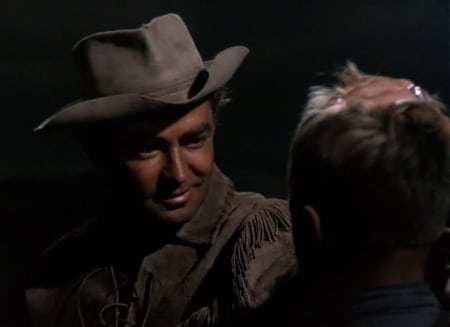Shane may be a vehement Western due to its adherence to several of the genre's tropes, but it's a film that belies its genre. By the 1950s, the American Western genre had become predictable, with Westerns growing to the point of being interchangeable, but 1953's Shane is bolder and smarter than more formulaic genre offerings from the same period. This is a film that focuses on storytelling and depth of character, not to mention its technical credits are superlative. Additionally, screenwriter A. B. Guthrie Jr. imbues Shane with themes of family value, loyalty, courage and friendship, and its hotly-debated ending remains as powerful as ever. Though the film is perhaps overrated in some circles, it remains a landmark achievement that inspired multiple movies in the decades to follow.

The titular Shane (Alan Ladd) is a skilled gunslinger with a secretive past. Riding into an isolated Wyoming valley, Shane encounters the homestead of farmer Joe Starrett (Van Heflin), his wife Marian (Jean Arthur) and son Joey (Brandon De Wilde). It becomes apparent that he has ridden into a land feud between the homesteaders and cattle ranch boss Ryker (Emile Meyer). Ryker wants to re-establish control over the entire valley and drive the homesteaders out. Shane takes Starrett's side in a confrontation with Ryker's men and decides to live and work on Starrett's farm. Joey grows to idolise Shane, who seeks to stay out of trouble and make an honest living. However, with the homesteaders continually resisting, Ryker resorts to bringing in a hired gun named Jack Wilson (Jack Palance) to get his dirty work done.
The narrative of Shane is familiar all these years on; it's the tale of a gunfighter fed up with killing who attempts to go straight and lay down his weapons for good. But, of course, things do not work out as planned, and, in this case, Shane is forced to strap on his pistols again for the greater good. The formula has been repeated countless times since, most notably for Clint Eastwood's western Unforgiven. Fortunately, its imitators do not diminish Shane, which remains fresh-feeling all these years on. The film actually incorporates a lot of Joey's perspective - viewers share his viewpoint, travelling alongside the boy as his innocence is shattered and he learns grave things about life and death. However, the problem with Shane is one of pacing; it's too long and glacial. It feels its almost two-hour runtime, as the storytelling is not always engaging. Things grow particularly weary during the second half when the titular character is relegated to more of a background player. The climax, though, is satisfying, but the way it ends will likely be polarising.

Before working as a director, George Stevens was a cinematographer, which gave him knowledge about smooth and beautiful camerawork. Shane is a visually impressive western, with eye-catching landscapes and wonderful production values. Stevens was a true perfectionist; filming for Shane wrapped in 1951, but it was in post-production for the better part of two years due to the intensive editing. The dedication is evident, as Shane is beset with standout set pieces. A large saloon brawl involving Shane, Joe and various goons is spectacular even by today's standards; fluid, gritty and hard-hitting. The editing, photography and sound design of this particular scene cannot be faulted. Luckily, this technical luminosity is often evident from start to finish. Stevens was also very insistent about being as true to the period as possible. An expert on the era was recruited, and sets and clothing had to be completely accurate. Stevens had witnessed the damage a gun could do to a man while serving in WWII and was disappointed that violence was so watered-down in films. Thus, bullets hit hard here, and the brawls are vicious. Following the aforementioned saloon fight, men are seen being patched up.
Although Ladd wasn't nominated for an Oscar (a baffling oversight), he submitted a truly bravura performance as the lonely wandering hero of the title. He embodied the role so well, conveying a certain charisma but nevertheless looking believable as a tough man of action. It's impossible to imagine any other actor playing Shane with the same confidence and excellence as Ladd. Luckily, the supporting cast is solid for the most part, with Palance a solid villain and an endearing De Wilde playing Joey. Meanwhile, Van Heflin is nicely amiable as Joe Starrett, but it's Jean Arthur who stands out as Joe's wife. Arthur's performance is brimming with passion.

Shane may be a Western with scenes of violence, but it's a family movie above all. It's a motion picture for everyone - the story is touching, with universally relatable themes, and the performances are great right down the line. The film has endured as a classic because, despite pacing issues, it's a well-made and thoughtful addition to the Western genre that's hard not to like.
7.9/10
 Login
Login